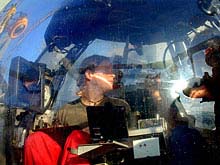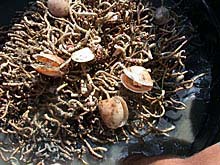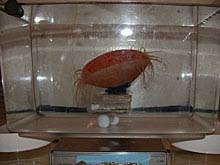
On my way to adventure! Next stop 2,000 feet down. I wonder what this button does…?. Click image for a larger view.
October 8, 2002
Johanna Jarnegren
Researcher
Today I am excited! I was going on my first dive ever to the bottom of the deep sea! A dream come true! Luckily the sea is calm and the submersible is working as it should. The mission of this dive is to collect a bivalve clam, Acesta bullisi.
At home in Norway, I work with a close relative of A. bullisi called Acesta excavata, or Giant Fileshell. The Giant Fileshell lives in the northeast Atlantic, often closely associated with a deep-water stony coral, Lophelia pertusa. During the last few years, I have tried to find out more about the Giant Fileshell’s feeding habits, how and when it reproduces, and its distribution and habitats. I want to do the same with its relative in the Gulf of Mexico.

A tubeworm bush with lots of Acesta bullisi. Notice how the clam sits over the opening of the tubeworm. Click image for larger view.
The Giant Fileshell has only been found in the northeast Atlantic, never anywhere else. So imagine my surprise yesterday when, on the very first dive of the cruise, Eric Cordes brought up clams of the genus Acesta that were spitting images of the Giant Fileshell. If these are the same species, then we have found them thousands of miles from where they are known to occur. I will have to take some home to compare them with the Norwegian ones to be certain. But if it isn’t the Giant Fileshell, then it is probably a new species, never described before! That’s not too bad either…
So, with these exciting discoveries in the back of my head, I entered the sub wondering what we would find on my first dive. The dive was a fantastic experience! Not only did we manage to collect tubeworms, fish, crabs, sea stars, snails, anemones and a sea cucumber, we also got several specimens of A. bullisi. These beautiful bivalves cling to the tubeworms. The larger ones actually sit with the upper end of the tubeworm inside the clam. Why they embrace the worm is not known, but I intend to find out.

This is the setup for measuring filtration rate of Acesta. The long outstretched tentacles and bright orange mantle edge indicate that the clam is relaxed and hopefully comfortable Click image for a larger view.
Meanwhile, I will work on the clams we collected. I’m doing experiments to find out if they filter feed (most clams feed by filtering tiny small particles from the water they pump over their gills) and if they do, how much water they filter per hour. I do these experiments by adding a certain amount of small unicellular algae to aquariums in which I keep the clams. I then take water samples while they are feeding, and count the number of algae remaining in each sample with an electronic instrument called a particle counter.
Until we started working on Acesta this year, nobody knew very much about how it reproduces. Now I have seen spawning in both the Norwegian species and A. bullisi from the Gulf of Mexico. These clams produce very large eggs that float up away from the bottom and develop while drifting in the plankton. Cool!
Sign up for the Ocean Explorer E-mail Update List.























